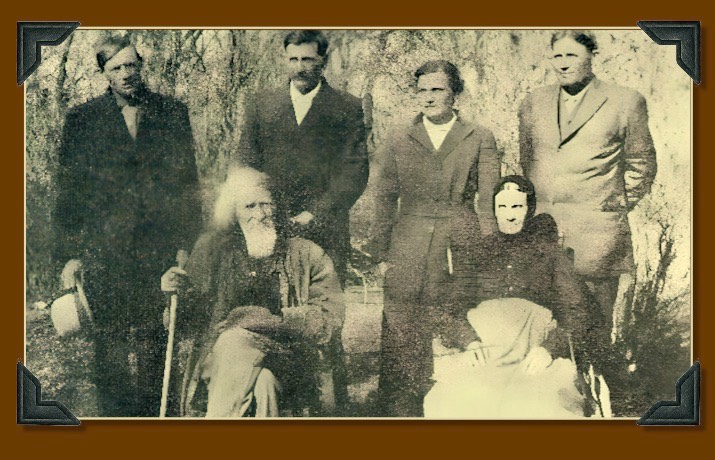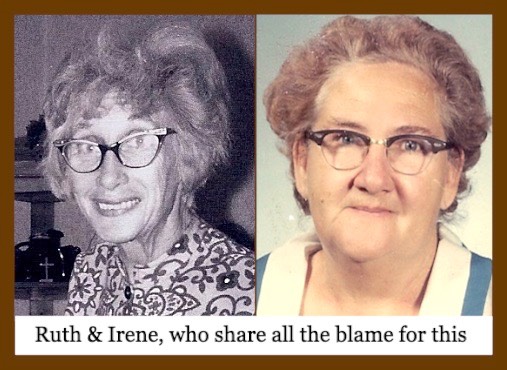Or at least pop a balloon and toss some confetti.
It was exactly ten years ago today that I posted my very first entry on the Lovewell History blog, the belated story of my trek to a family reunion a few months earlier. That was about 410 entries ago. Considering the fact that I was writing two or three pages a day in the beginning, it’s apparent that my output has dwindled considerably over the years. It’s also clear that I was suffering from insomnia in those days, a problem which no longer afflicts me. I used to get a lot more done at 2:00 a.m.
Anyway, this all leads back to a newspaper clipping my Aunt Ruth showed me back in the early 1960’s, as I’ll explain in bit. She has a lot to answer for.

I’ve been added and abetted by a lot of co-conspirators over the years. Even though Barb Gray lived on the West Coast she often alerted me to typos first thing in the morning, sometimes advising me that what I had written probably wasn’t what I meant to say. I chalk it up to the insomnia.
It’s great having a family member who’s an actual genealogist, and Mary Penner occasionally pops up just in time to offer invaluable advice. Without her suggestion I probably wouldn’t have paid by the pound for copies of Thomas Lovewell’s pension file. My wife has never heard me say “holy crap” so many times in the course of a couple of hours. Mary recently made the pilgrimage to Lovewell Pond in Maine, gazing adoringly at the monument, she says, for at least as long as Capt. John lasted during the famous fight.
By the way, the picture of the monument on this site is the single most-viewed page herein, and I borrowed it (with attribution) from someone else’s blog. I noticed that it pops up first when you Google “monument at Lovewell Pond.” It’s the most-viewed because it pops up first, and it pops up first because it’s the most-viewed. That’s the way Google Search works.
Dave Lovewell was great at noodling about on the Internet. I think he had insomnia too. Aside from our long-running debate over the dating of the photograph of a family reunion, he’s the one who first alerted me to evidence that Thomas was bidding on mail routes in Territorial Kansas. He also kept dropping suggestions that led to The Great Postal Caper.
Keith Jones pointed out the actual location of the Nottingham Post Office in Marshall County, the terminus of Thomas Lovewell’s mail route, and provided clues about a nearby suspected safe-house on the Underground Railroad. Keith also contributed substantially to a dozen blog posts on Marshall County history, including those concerning the Irving tornado, which are consistently some of the most-read pages here.
Scott Pierce, who began reading the blog years ago when he was stationed in Iraq, tipped me off about Col. Nehemiah Lovewell’s role in a Revolutionary War kidnapping plot. It’s a reminder that the Civil War was not the first time American families found themselves divided over allegiance to a cause. It’s also a cautionary tale about a spy network being only as effective as its least capable members, and this one was hilariously rife with incompetence.
When Scott pointed out that the story should be right up my alley, he may have been slyly alluding to my companion website, www.deciphering007.com, my take on Ian Fleming’s later Bond Thrillers. It exists mostly because it costs no more to have a site piggyback on another I already pay for.
The gist of my thesis is that Fleming quickly tired of catering to a niche market, turning out a series of books that not only declined in quality every year, but failed to catch on in America. His solution was to take great care in adapting Walt Disney’s Cinderella as an espionage thriller that sneakily morphs into Sleeping Beauty, which would be Disney’s very next animated masterpiece. The result was Fleming’s own masterwork, From Russia With Love. Very clever.

Fleming followed up with Dr. No, which is a fairly literal adaptation of Disney’s live-action 20,000 Leagues Under the Sea. Following Disney’s lead gave Fleming the assurance of a solid framework for his novels. If it had already clicked with a movie audience, it should work just fine as a book. Just remember to change the names.
While he later branched out with titles that were based on Arthurian legends and Middle-English literature, it was the very same route Disney was already charting. Fleming’s version of Sir Gawain and the Green Knight (On Her Majesty’s Secret Service) came out the same year as Disney’s The Sword In the Stone.
Lest you think I’ve drifted rather far afield I should point out that my Aunt Ruth first showed me a picture of Thomas Lovewell with his family and recited what she knew of her mother’s story, around the same time my Aunt Irene handed me a copy of Goldfinger. Stick around long enough, you’ll start writing about your childhood. Yes, that’s apparently what happens.
One of these days I really need to overhaul the site entirely. Until then, my sincere apologies for anyone struggling to read this on a smartphone. I hope your eyes are young and strong.